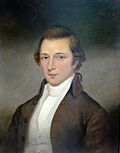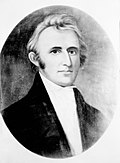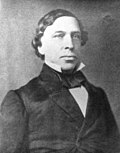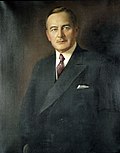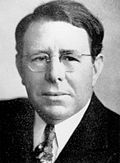Top Qs
Timeline
Chat
Perspective
List of governors of North Carolina
List of heads of government in the state of North Carolina From Wikipedia, the free encyclopedia
Remove ads
The governor of North Carolina is the head of government of the U.S. state of North Carolina and commander-in-chief of the state's military forces.
There have been 70 governors of North Carolina, with six serving non-consecutive terms, totaling 76 terms. The current governor is Democrat Josh Stein, who took office on January 1, 2025.
The most recent death of a former Governor was that of James Holshouser who passed away in 2013 at age 78
The oldest living former governor is James G. Martin at age 89
Remove ads
Governors
Summarize
Perspective
Presidents of the Council
Prior to declaring its independence, North Carolina was a colony of the Kingdom of Great Britain. The 13-member Provincial Council, renamed the Council of Safety in April 1776, was essentially the executive authority during the second year of the revolution, and was appointed by the Provincial Congress. The Presidency of the Council and the Presidency of the Congress could each be considered the highest offices in the state during this time, but the council was supreme when the congress was not in session.
Cornelius Harnett served as the first president from October 18, 1775, to August 21, 1776. Samuel Ashe then served until September 27, 1776, and Willie Jones until October 25, 1776, at which time a state government had been formed.[1]
State governors
North Carolina was one of the original Thirteen Colonies, and was admitted as a state on November 21, 1789.[2] It seceded from the Union on May 20, 1861,[3] and joined the Confederate States of America on February 4, 1861.[4] Following the end of the American Civil War, North Carolina during Reconstruction was part of the Second Military District, which exerted some control over governor appointments and elections. North Carolina was readmitted to the Union on July 4, 1868.[5]
The first constitution of 1776 created the office of governor, to be chosen by the legislature annually, and whom may only serve up to three out of every six years.[6] An amendment in 1835 changed this to popular election for a term of two years,[7] allowing them to succeed themselves once.[1] The 1868 constitution lengthened terms to four years, to commence on the first day of January after the election,[8] but they could not succeed themselves,[9] a limit that was changed in 1977 to allow them to succeed themselves once.[10]
The office of lieutenant governor was created in 1868, to act as governor when that office is vacant;[11] in 1971 this was changed so that the lieutenant governor becomes governor.[12] Before the office was created, the speaker of the senate would act as governor should it be vacant.[13] The governor and the lieutenant governor are not officially elected on the same ticket.
Remove ads
See also
Notes
- The office of lieutenant governor was created in 1868.[14]
- Under the 1776 constitution, governors were ineligible to hold the office more than three years in six successive years.[19]
- Burke was captured by Loyalists led by David Fanning on September 13, 1781, and escaped on January 16, 1782;[22] during this time, Speaker of the Senate Alexander Martin acted as governor.[23]
- Johnston resigned, having been elected to the United States Senate.[30]
- Spaight is labeled a Federalist by Kallenbach,[31] and a Democratic-Republican by Glashan.[20]
- Ashe is labeled an Anti-Federalist by Kallenbach,[31] and a Democratic-Republican by Dubin[36] and Glashan.[20]
- Kallenbach labels Williams a Democratic-Republican,[31] but Glashan[20] and Lampi[44] label him a Federalist.
- Smith was nominated and received votes in the first round of balloting, but he had not authorized this and was not interested, so his name was withdrawn.[59]
- Iredell was instead elected to the United States Senate on December 1; while Sobel says he resigned to take his new office,[77] contemporary sources mention no such resignation.
- Glashan[20] and Kallenbach[31] label Owen a Democratic-Republican, while Sobel says he was a "National Republican with Federalist sympathies."[80]
- Stokes was appointed to be a commissioner to treat with Indians, and sent a farewell message to the general assembly on November 19.[87] Some sources, both modern and older, interpret this as him resigning;[84][88] however, the 1927 manual says he left office normally on December 6,[1] and contemporary news does not use any term of resignation.
- Under an 1835 amendment to the constitution, governors were ineligible to hold the office more than four years in six successive years.[98]
- Reid resigned, having been elected to the United States Senate.[111]
- After the Union victory in the Battle of New Bern, Abraham Lincoln appointed General Edward Stanly as military governor of the Union-held regions of North Carolina, and he served in that capacity from May 26, 1862, until early 1863, when he resigned over the Emancipation Proclamation.[124]
- Vance left Raleigh on April 12 to negotiate a surrender,[128] surrendered to General John Schofield on May 2, and was arrested in Statesville on May 13. He was released a few weeks later, and would be pardoned by Andrew Johnson in 1867.[129]
- Holden was impeached over crimes committed during the Kirk–Holden war against the Ku Klux Klan.[130]
- Vance resigned, having been elected to the United States Senate.[125][146]
- Under the 1868 constitution, governors were ineligible to hold the office more than four years in eight successive years.[150]
- Robinson acted as governor from September 1 to September 28, 1883, while Jarvis was out of state.[151]
- Under a 1962 amendment to the constitution, governors were ineligible to succeed themselves.[215]
- Under the 1971 constitution, governors were ineligible to succeed themselves.[222]
- Represented the Democratic Party
- Under a 1977 amendment to the constitution, governors are ineligible for election to more than two consecutive terms.[229]
- Represented the Republican Party
Remove ads
References
External links
Wikiwand - on
Seamless Wikipedia browsing. On steroids.
Remove ads












